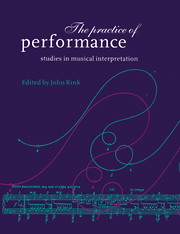Book contents
- Frontmatter
- Contents
- Preface
- PART ONE FUNDAMENTALS
- PART TWO STRUCTURE AND MEANING IN PERFORMANCE
- PART THREE PERFORMANCE AS PROCESS
- 9 Performance and analysis: interaction and interpretation
- 10 Analysis and the act of performance
- 11 The pianist as critic
- 12 Playing in time: rhythm, metre and tempo in Brahms's Fantasien Op. 116
- Index
9 - Performance and analysis: interaction and interpretation
Published online by Cambridge University Press: 10 October 2009
- Frontmatter
- Contents
- Preface
- PART ONE FUNDAMENTALS
- PART TWO STRUCTURE AND MEANING IN PERFORMANCE
- PART THREE PERFORMANCE AS PROCESS
- 9 Performance and analysis: interaction and interpretation
- 10 Analysis and the act of performance
- 11 The pianist as critic
- 12 Playing in time: rhythm, metre and tempo in Brahms's Fantasien Op. 116
- Index
Summary
‘Players should understand what they play.’ This pithy pronouncement, at the start of Donald Francis Tovey's Companion to Beethoven's Pianoforte Sonatas (1931: iii), articulates one of the prime rationales for producing and publishing music analyses. Like most analysts, Tovey lists, discusses and graphically depicts both obvious and subtle features of the music, apparently on the assumption that this knowledge will be immediately useful to performers. Occasionally, theorists suggest or even insist on specific performance directions based on their analyses, as Heinrich Schenker does in his 1925 essay on the Largo from J. S. Bach's Sonata in C major for Solo Violin. More recent literature includes two notable books aimed at performers which explain how analysis would help them: Edward T. Cone's Musical Form and Musical Performance (1968) and Wallace Berry's Musical Structure and Performance (1989), the latter including many more specific performance directions than the former. Within the past decade, additional articles and review-articles specifically address the relation of analysis to performance (especially Schmalfeldt 1985, Dunsby 1989, Rink 1990 and Howell 1992).
I suggest that with rare and quite circumscribed exceptions something is strikingly absent from this literature – namely, performers and their performances. Tovey, Schenker, Berry, Cone and Howell never validate an analysis by referring to singular performances, and Berry even questions the very integrity of any performance which is not based on analytical insight and rigour: ‘The purely spontaneous, unknowing and unquestioned impulse is not enough to inspire convincing performance … [Although the interpreter's impulsive response to the score can fortuitously hit on convincing approaches through a developed (if often unreasoned) sense of appropriateness, the purely intuitive is unlikely to afford a necessary grasp of – or place in … the comprehended whole’ (1989: 217–18).
- Type
- Chapter
- Information
- The Practice of PerformanceStudies in Musical Interpretation, pp. 197 - 216Publisher: Cambridge University PressPrint publication year: 1995
- 29
- Cited by

